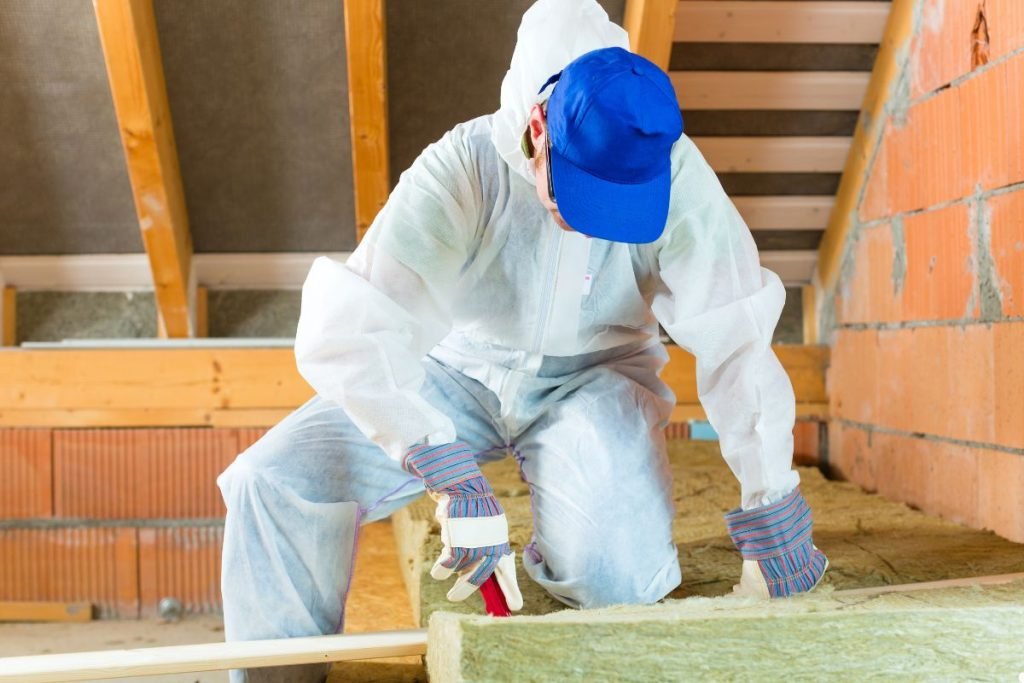
Proper attic insulation is one of the most effective ways to improve your home’s comfort year-round and significantly reduce your heating and cooling costs. By acting as a thermal barrier, it prevents unwanted heat transfer, keeping your home warmer in the winter and cooler in the summer, leading to substantial energy savings and a more comfortable living environment. This guide covers everything US homeowners need to know about optimizing their attic insulation. Ready to improve your home’s efficiency? Call us today to schedule your free insulation consultation!
Why Your Attic Insulation Matters More Than You Think
Many homeowners focus on windows, doors, or HVAC systems when thinking about energy efficiency, often overlooking the powerhouse working silently above their heads: the attic insulation. Your attic is a major area where heat can escape during winter and intrude during summer. Inadequate or damaged insulation means your heating and cooling systems have to work much harder, leading to higher energy bills and inconsistent temperatures throughout your home. Investing in proper attic insulation isn’t just an upgrade; it’s a fundamental step towards a more efficient and comfortable home.
What Exactly is Attic Insulation?
At its core, attic insulation is material installed within your attic space designed to resist the flow of heat. Heat naturally moves from warmer areas to cooler areas through three methods: conduction (transfer through materials), convection (transfer through air or liquid movement), and radiation (transfer via electromagnetic waves). Good insulation effectively slows down this heat transfer process. Think of it like a thermal blanket for your house – it helps maintain the desired temperature inside by minimizing the influence of outside temperatures, whether it’s freezing cold or blazing hot. The effectiveness of insulation is measured by its R-value, which we’ll explore later.

Top Benefits of Proper Attic Insulation
Upgrading or installing the right amount of attic insulation offers numerous advantages that extend beyond just temperature control:
Lower Energy Bills
This is often the primary motivator. By reducing heat loss in winter and heat gain in summer, your HVAC system runs less often and more efficiently. This directly translates to noticeable savings on your monthly heating and cooling costs, potentially saving homeowners 10-20% or even more, according to ENERGY STAR.
Improved Home Comfort
Say goodbye to drafty rooms in winter and stuffy upper floors in summer. Proper insulation creates more consistent temperatures throughout your home, eliminating hot and cold spots and making your living space significantly more comfortable year-round.
Enhanced HVAC Lifespan
When your heating and cooling systems don’t have to constantly battle heat transfer, they experience less wear and tear. This reduced strain can lead to fewer breakdowns and potentially extend the lifespan of your expensive HVAC equipment.
Increased Home Value
Energy efficiency is a desirable feature for homebuyers. A well-insulated attic is a tangible asset that can increase your home’s resale value and make it more attractive on the market.
Noise Reduction
Insulation doesn’t just block thermal energy; it also absorbs sound waves. Adding insulation to your attic can help dampen external noises like traffic, airplanes, or weather, creating a quieter indoor environment.
Environmental Impact
By using less energy to heat and cool your home, you reduce your carbon footprint. Proper insulation helps conserve natural resources and lower greenhouse gas emissions associated with power generation.
Exploring Common Attic Insulation Materials
Several types of insulation are commonly used in US attics, each with its own characteristics:
Fiberglass (Batts and Blown-in)
Made from fine glass fibers, fiberglass is one of the most common insulation materials. It comes in pre-cut batts (blankets) designed to fit between standard joist spacing, or as loose-fill (blown-in) material. It’s generally cost-effective but requires careful handling to avoid skin and respiratory irritation. Fiberglass insulation performance depends heavily on proper installation.
Cellulose (Blown-in)
Typically made from recycled paper products treated for fire and insect resistance, cellulose is almost always installed as loose-fill using a blowing machine. It fills irregular spaces well and often has a high recycled content, making it an eco-friendly choice. It can settle over time, potentially reducing its R-value.
Spray Foam (Open-cell and Closed-cell)
Applied as a liquid that expands to fill cavities, spray foam insulation creates an excellent air seal.
- Open-cell spray foam is lighter, less expensive, and provides good sound dampening but has a lower R-value per inch and is vapor-permeable.
- Closed-cell spray foam is denser, offers a higher R-value per inch, adds structural rigidity, and acts as a vapor barrier. It’s generally more expensive. Spray foam application requires professional installation.
Mineral Wool (Rock Wool/Slag Wool)
Made from rock (basalt) or recycled slag (an industrial byproduct), mineral wool comes in batts or loose-fill. It offers excellent fire resistance, good soundproofing qualities, and is moisture-resistant. It’s often more expensive than fiberglass or cellulose.
Choosing the Right Insulation: R-Value and Climate Zones
Selecting the correct insulation involves understanding two key factors:
Understanding R-Value
R-value measures an insulation material’s ability to resist heat flow. The higher the R-value, the better the insulation performance. It’s important to note that R-value is additive; the total R-value of your attic insulation is the sum of the R-values of all layers present. Doubling the thickness roughly doubles the R-value.
US Climate Zones and Recommended R-Values
The amount of insulation you need depends heavily on where you live. The U.S. Department of Energy (DOE) divides the country into climate zones, each with recommended R-value ranges for attics. Colder northern zones require higher R-values (e.g., R49-R60) than warmer southern zones (e.g., R30-R49). You can find your zone and recommendations on the ENERGY STAR website.
Existing Insulation Assessment
Before adding new insulation, it’s crucial to assess what you currently have. Check the type, depth, and condition. Is it damaged by moisture or pests? Is it compressed? Knowing the existing R-value helps determine how much more insulation is needed to reach the recommended level for your climate zone.
DIY vs. Hiring a Professional Insulation Contractor
Should you tackle attic insulation yourself or call in the pros? Consider these points:
Pros and Cons of DIY Attic Insulation
- Pros: Potential cost savings on labor. Satisfaction of completing a home improvement project.
- Cons: Can be physically demanding, messy, and potentially hazardous (working in confined spaces, dust, handling materials like fiberglass). Requires proper safety gear (respirator, gloves, eye protection). Achieving correct installation (especially avoiding compression and ensuring even coverage with blown-in) can be tricky and impact performance. Risk of damaging wiring, vents, or trusses. Need to rent equipment for blown-in insulation.
When to Call the Experts
Hiring professionals is often recommended, especially for:
- Spray foam installations (requires specialized equipment and expertise).
- Large or complex attics.
- Dealing with significant air leaks that need sealing first.
- Removing old or contaminated insulation.
- If you lack the time, physical ability, or desire to do it yourself safely and effectively.
Finding a Qualified Contractor
Look for experienced, licensed, and insured insulation contractors. Get multiple quotes, check reviews and references, and ensure they understand local building codes and R-value recommendations. Ask about their process for air sealing before insulating, as this is crucial for maximum effectiveness. Finding reputable local contractors.
What Does Attic Insulation Cost?
The cost of insulating your attic can vary widely based on several factors:
Factors Influencing Cost
- Attic Size: Larger attics require more material and labor.
- Insulation Type: Spray foam is typically the most expensive, followed by mineral wool, then fiberglass and cellulose.
- Required R-Value: Higher R-value targets mean more material is needed.
- Labor Costs: Professional installation fees vary by region and contractor.
- Attic Condition & Accessibility: Difficult access, obstructions, or the need for extensive air sealing or old insulation removal will increase costs.
- Removal of Old Insulation: If existing insulation is damaged or contaminated, removal adds to the expense.
Average Cost Ranges
While prices fluctuate, homeowners might expect to pay anywhere from $1.50 to $5.00+ per square foot installed, depending heavily on the factors above. Blown-in fiberglass or cellulose usually falls in the lower to mid-range, while spray foam occupies the higher end. Getting personalized quotes is essential.
Potential Rebates and Incentives
Check for federal tax credits, state programs, or local utility company rebates for energy efficiency upgrades like adding attic insulation. These incentives can significantly reduce the overall project cost. The Database of State Incentives for Renewables & Efficiency (DSIRE) is a good resource.
Keeping Your Attic Insulation Effective
Once installed, your attic insulation requires minimal maintenance, but occasional checks can ensure it continues performing optimally:
Regular Inspections
Visually inspect your attic insulation annually or biannually. Look for unevenness, compression, or areas that look thin. Ensure vents (like soffit vents) are not blocked by insulation, as proper attic ventilation works hand-in-hand with insulation.
Signs of Problems (Damage, Pests, Moisture)
- Moisture: Wet or damp insulation loses R-value and can lead to mold growth. Look for water stains on the insulation or roof deck. Address any roof leaks or ventilation issues immediately.
- Pests: Rodents or insects can tunnel through insulation, reducing its effectiveness and creating unsanitary conditions. Look for droppings or nesting signs. Address pest issues promptly and repair damaged insulation. Protecting your attic from pests is important.
- Compression: Avoid storing items directly on top of loose-fill or batt insulation, as compression reduces its R-value. Use raised storage platforms if needed.
Protecting Insulation
Be careful when working in the attic not to step on or disturb the insulation unnecessarily. Ensure baffles are in place near soffit vents to prevent insulation from blocking airflow.

Your Attic Insulation Questions Answered
Here are answers to some common questions homeowners have about attic insulation:
How much attic insulation do I need?
This depends primarily on your climate zone. Consult the DOE/ENERGY STAR recommendations for your specific region, typically aiming for R-values between R30 and R60 for most US attics. Contact us today for expert insulation guidance tailored to your region!
Can I put new insulation over old insulation?
Yes, in many cases, you can add new insulation on top of existing insulation, provided the old insulation is dry, clean, and free of mold or pest contamination. Ensure you don’t mix incompatible types (like covering vents) and don’t install faced batts on top of existing insulation (which can trap moisture). If unsure, consult a professional.
How long does attic insulation last?
The lifespan varies by material. Fiberglass, cellulose, and mineral wool can last for decades (often 20-30 years or much longer) if undisturbed and kept dry. Spray foam generally lasts for the life of the building. However, effectiveness can decrease over time due to settling (cellulose), compression, moisture, or pest damage.
Is attic insulation flammable?
Most common insulation materials (fiberglass, mineral wool, cellulose) are treated with fire retardants to meet safety standards, making them fire-resistant, not fireproof. Spray foam formulations also have fire retardants. It’s crucial that insulation is not installed too close to heat sources like recessed lighting (unless IC-rated) or chimneys.
Does attic insulation help in the summer?
Absolutely! Insulation works year-round. In summer, it resists the flow of heat from the hot attic into your cooler living spaces below. This reduces the workload on your air conditioner, saving energy and keeping your home more comfortable.
Invest in Your Comfort: Final Thoughts
Investing in proper attic insulation is one of the smartest home improvement projects a US homeowner can undertake. The benefits – significant energy savings, vastly improved year-round comfort, extended HVAC lifespan, increased home value, and a quieter living environment – provide an excellent return on investment. By understanding the types of insulation, recommended R-values for your climate, and the importance of proper installation (whether DIY or professional), you can ensure your attic is working effectively to keep your home comfortable and your energy bills manageable for years to come. Don’t underestimate the power of what’s above your ceiling! Call us today to schedule your attic insulation consultation and start saving energy and money!
